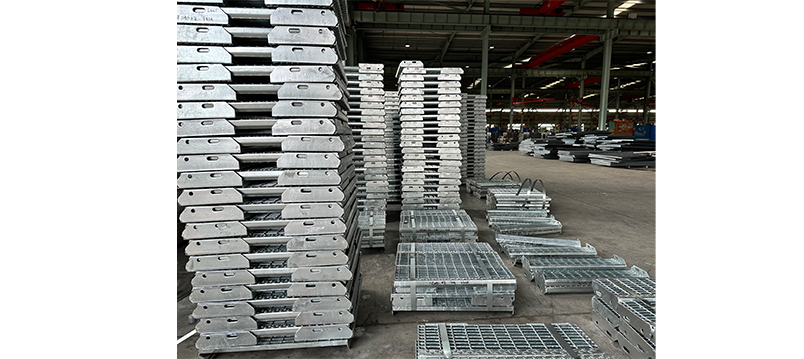Steel grating, also known as steel grid, grating plate, or grating cover, is a new type of steel structural material widely used in various industrial and construction projects. Its main feature is a mesh structure formed by flat steel bars arranged at certain intervals and crossbars welded together. The surface can be treated for corrosion resistance to enhance its durability and anti-corrosion capabilities. The standard names for steel grating in China are standardized in YBT4001.1-1998 and YBT4001.1-2007. Depending on different usage requirements, steel grating can be divided into various types and specifications. Below, we will provide a detailed introduction to the composition, classification, and applications of steel grating.

Steel grating is primarily composed of flat steel bars (transverse load-bearing steel) and crossbars (longitudinal connecting rods). These components are combined through welding or press-locking processes to form a sturdy grid structure. The standard material is generally carbon steel (Q235), but in special environments such as boilers and the chemical industry, higher strength steel like Q345 may be used. The surface of the steel grating is often treated with hot-dip galvanizing to enhance corrosion resistance and extend its service life.
Pressure-Welded Steel Grating: Produced using large pressure welding machines, it has high strength and is commonly used for heavy-duty platforms or walkways.
Interlocked Steel Grating: Manufactured through an interlocking connection method, it is suitable for lighter applications.
Locking Steel Grating: Uses a locking connection, making it easy to install, and is often used in walkways and bridges.
Perforated Steel Grating: Features perforations in the grating, suitable for areas with special requirements for air circulation and drainage.
Plain Steel Grating: Simple structure, suitable for general platforms or industrial areas.
Serrated Steel Grating: The serrated design increases anti-slip functionality, ideal for high-moisture environments such as chemical plants and offshore platforms.
I-shaped Steel Grating: Offers higher strength, suitable for environments with high load-bearing requirements.
Platform steel grating: Widely used in industrial platforms, bridges, and trestles.
Step board steel grating: Used for steps in steel ladders and staircases, offering good anti-slip properties.
Trench cover steel grating: Used as covers for ditches and drainage channels, providing good water permeability and load-bearing capacity.
Carbon steel grating: Commonly used steel grating suitable for general environments.
Stainless steel grating: Offers stronger corrosion resistance, suitable for high-demand special industries such as marine engineering and chemical plants.
Steel grating is widely used in multiple industries due to its excellent ventilation, lighting, heat dissipation, anti-slip, and corrosion resistance properties, making it suitable for various complex environments.
Petrochemical Industry: Steel grating is extensively used in platforms, trestles, walkways, and trench covers in the petrochemical industry. Its corrosion resistance is particularly important in harsh chemical environments.
Power Industry: Used in ground platforms of power plants and substations, steel grating offers strong load-bearing capacity and good ventilation, aiding in heat dissipation.
Architectural Decoration and Municipal Engineering: In urban public facilities, steel grating is used not only in practical locations but also as decorative elements, such as park walkways and city squares.
Ports and Transportation Facilities: Steel grating is used in ports, docks, bridge railings, and road drainage ditches, capable of bearing heavy loads and providing excellent water permeability.
Environmental and Sanitation Engineering: Steel grating is also widely used in urban drainage covers, garbage treatment plants, and sewage treatment plants, preventing sewage backflow and ensuring smooth drainage.
The specifications of steel grating usually include the following aspects:
Longitudinal bar (flat steel) spacing: Commonly 30mm, 40mm, 60mm, with non-standard spacings such as 25mm, 33mm, 50mm, etc.
Crossbar (twisted steel) spacing: Commonly 50mm, 100mm, with other options like 38mm, 76mm, etc.
Height: Generally between 20mm and 500mm.
Thickness: Common thicknesses range from 3mm to 15mm. The identification method of steel grating usually uses a combination of letters and numbers to indicate specifications. For example, a steel grating marked as “6325/0/508” indicates flat steel with a height of 32mm and a thickness of 5mm, flat steel spacing of 30mm, and crossbar spacing of 50mm, while “S” indicates serrated steel grating.
As a powerful and versatile industrial material, steel grating plays an important role in various industries due to its unique structure and superior performance. From industrial platforms to municipal engineering and environmental facilities, steel grating is increasingly important in modern construction. Choosing the right specifications and materials for steel grating can ensure the success and long-term value of a project.